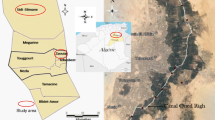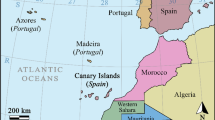Abstract
Sandstones from the Free State province in South Africa have been mined and processed mainly by small scale and artisanal miners in the rural areas. In the present investigation basic fire proof and water absorption tests, X-ray and γ-ray based characterisation techniques were used to study the sandstones. The collected samples were grouped according to their apparent colour in day light conditions and the elemental analysis showed the presence of a high amount of oxygen (>52%) and silicon (>38%) with Mn, Al, Fe and Ca as major elements in proportions related to the colour distribution of the various sandstones. The uniaxial compressive stress was found to be the highest (56 MPa) for the greyish sandstone and the lowest (8 MPa) for the white sandstone sample, also associated with the lowest (Al+Fe)/Si value of 0.082. The humidity test showed that the 6 % water absorption was lower than the recommended ASTM value of 8 %. The sandstone samples were also subjected to various high temperatures to simulate possible fire conditions and it was found that the non alteration of the mineral species might be one of the reasons why the sandstones are regarded as the most refractory amongst the building materials typically used. Mössbauer spectroscopy revealed that iron is present in all the sandstones, mainly as Fe3 + with the black sandstone showing an additional presence of 3 % Fe2 + indicating that a higher iron content coupled to higher silicon content, contributes to an increase in the uniaxial compressive strength.
Similar content being viewed by others
References
Viljoen, M.J., Reimold, W.U.: An Introduction to South Africa’s Geological and Mining Heritage, The Geological Society of South Africa and Mintek, 1st Edition, ISBN 0 86999 941 9, p. 193 (1999)
de Jager, F.S.J.: Mineral resources of South Africa. In: Coetzee, C.B. (ed.) Dept. of Mining and The Geological Survey of South Africa, 5th edition, ISBN 0 621 03465 7, p. 462 (1976)
Norman, N., Whitfield, G.: Geological Journeys, Struik Publishers, South Africa, ISBN 1 77007 0621, p. 320 (2006)
van Dijk, D.E.: Taphonomic aspects of the Wagondrift Quarry site and their implications for the depositional environment of the upper Permian Estcourt Formation. S. Afr. J. Geol. 114.2, 105–109 (2011)
MacRae, C.: Life etched in stone – Fossils of South Africa, Geological Society of South Africa, 1st Edition ISBN 0-620-23388-5, p. 305 (1999)
http://www.equities.com/news/headline-story?dt=2012-11-16&val=721733&cat=energy. Accessed 16 Nov 2012
Author information
Authors and Affiliations
Corresponding author
Additional information
International Symposium on the Industrial Applications of the Mössbauer Effect (ISIAME 2012), Dalian, China, 2–7 September 2012
Rights and permissions
About this article
Cite this article
Mulaba-Bafubiandi, A.F., Waanders, F.B. 57Fe Mössbauer and X-ray characterisation of sandstones. Hyperfine Interact 218, 123–131 (2013). https://doi.org/10.1007/s10751-013-0763-3
Published:
Issue Date:
DOI: https://doi.org/10.1007/s10751-013-0763-3




